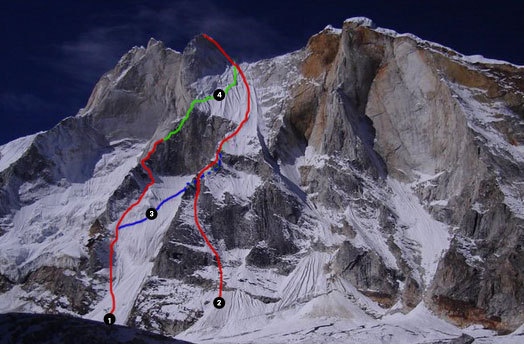
Meru Central (6310m) in India’s Gangotri Region, showing 1. The Valeri Babanov spring 2001 attempt. 2. Shangri La (ED 5.9/5.10 A1/A2 M5 75 degrees), established by Babanov in 2001. 3. The 2006 Japanese Variant. 4. The Czechs variant established by Marek Holecek and Jan Kreisinger in October, 2006. The Shark’s Fin is the 400-meter-high prow of stone that leads to Meru Central’s summit. Despite numerous attempts, the Shark’s Fin remains unclimbed. [Photo] Makoto Kuroda
In the November 16 NewsWire, we reported the “possible second” ascent of Meru Peak. On October 6 Czech mountaineers Marek Holecek and Jan Kreisinger reached the summit of Meru Central (6310m) in India’s Gangotri Region via a variation to the route climbed in 2001 by Valeri Babanov. Now it appears the Czech climbers were the third party to reach the summit: a few days before their bid a team of four Japanese climbers, also aspirants for the oft-attempted 400-meter-high blade of granite that gives the Shark’s Fin its name, completed the second ascent, via yet another variant to Babanov’s efforts.
Babanov originally attempted Meru Central in Spring 2001, by a snow-and-ice line that parallels a spine of stone extending down from the Fin’s final headwall nearly the entire way to the glacier (it is unclear how many times this line had been climbed previous to Babanov’s attempt). Babanov reached ca. 5800 meters, and though he failed to climb the Shark’s Fin, his attempt provided a critical reconnaissance of the peak that the Russian applied to a successful solo ascent a number of months later: Shangri La (ED 5.9/5.10 A1/A2 M5 75 degrees). This ascent was the first of the mountain, but it left the prime objective–the Shark’s Fin itself–unclimbed.
Like numerous teams before them, the Japanese contingent of Hiroyoshi Manome, Yasushi Okada, Makoto Kuroda and Yasuhiro Hanatani arrived at the base of Meru Central hoping to bag the Shark’s Fin. They also had a bit of historical momentum: in 2004 they reached 6100 meters on an attempt on the Shark’s Fin, but Hanatani broke both his legs, necessitating a retreat.
This year the team again began their attempt, as Babanov and others had before them, to the right of the long spine extending from the Shark’s Fin’s headwall. Progressing capsule style up the route only to encounter four days of bad weather. With the Shark’s Fin itself now unlikely, the team deviated farther to the right, and climbed a three-pitch mixed headwall of “loose rock” to join the upper slopes Babanov had used for his autumn 2001 ascent. “A lot of ice and mixed climbing led us the summit ledge,” wrote Makoto Kuroda. “Under the snow roof there was deluxe biy site for sleepingbagless climbers. Day 3 started with warm sunshine, but a hard, cold wind on the back side of Meru froze us very quickly. At 7:30 a.m., September 26, atop the summit and beneath the Himalayan blue, we said to each other, ‘Yes, we did it!?'”
Descending the route of ascent, the team left numerous V-threads. They had made the second ascent of the mountain in three days camp to camp from Camp I at 5300 meters.
The Czech team, which the Japanese encountered at Camp I on their descent, also followed Babanov’s Spring 2001 itinerary, and eventually pushed their line even higher than he had, to 5900 meters, where they began their headwall attempts as others had before them. Ultimately, however, exhaustion forced them, too, to abandon the coveted headwall and follow the line climbed by the Japanese a week earlier. It is unclear whether the Japanese ascent facilitated their own in ways such as precut steps, bivy platforms, V-threads or fixed lines.